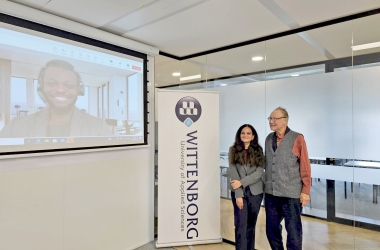Wittenborg Online News!
Research Explores Factors that Influence Consumer Preferences on Food Delivery Platforms
Research Explores Factors that Influence Consumer Preferences on Food Delivery Platforms

Anjali Wadhwa’s MBA Thesis
Research Explores Factors that Influence Consumer Preferences on Food Delivery Platforms
Highlights Importance of Attributes Such as Restaurant Rating
With food delivery platforms becoming increasingly widespread, what factors shape consumer preferences when using these services?
Intrigued by this question, Wittenborg graduate Anjali Wadhwa decided to explore it in her thesis. Originally from India, Anjali recently completed an MBA in Data Analytics.
“This subject is relevant due to the significant growth of food delivery platforms in India, which have revolutionised consumer dining habits by offering convenience and variety. For restaurant owners and platforms, understanding consumer preferences in restaurant selection is crucial for improving customer satisfaction, optimising offerings and staying competitive in this rapidly evolving industry,” the graduate explains.
She highlights that the topic bridges her interest in consumer behaviour with the thriving food-tech sector. “Moreover, the diversity within the Indian market provides a rich context for examining how factors like price, delivery time and such influence decisions. By using conjoint analysis, a robust methodology for understanding decision making, my research aims to fill a gap in the literature and provide actionable insights for stakeholders in the food delivery ecosystem.”
To gather information for her study, Anjali relied on an online survey. Her target demographic was professionals working in cities, who are more inclined towards ordering food online. In total, 230 responses were collected.
The survey questions were divided into two distinct sections, with the first focusing on different categories of consumer demographics, such as age, income level, occupational category, frequency of online delivery order per month, preferred meal of the day for food delivery and personal vehicle ownership.
The second section of the survey included hypothetical restaurant profiles with varying attributes. The participants were asked to rate scenarios based on their likelihood to select the profiles mentioned for purchase on a food delivery app.
The study considered five attributes for the analysis – menu variety, menu pricing, delivery time, number of online reviews and restaurant rating. Anjali’s research shows that restaurant rating, with 40% relative importance score, is the consumers’ preferred attribute, followed by menu pricing (29%) and delivery time (17%). In contrast, the number of online reviews and menu variety had a smaller impact on decision making, with 9% and 5% relative importance score respectively.
A comparison between perceived and actual rankings revealed that while restaurant rating was consistently ranked highest in customer reported ranking as well as conjoint analysis, other attributes like menu variety, menu pricing and delivery time showed discrepancies.
“Menu variety is perceived as the second most important attribute by the respondents’ self-reported ranking but ranks fifth by statistical analysis. Menu pricing, in turn, is perceived as the third most important attribute but ranks second, while delivery time, perceived as the least important, statistically ranks third. This comparison between perceived importance and actual influence on choices highlights the effectiveness of conjoint analysis in identifying genuine consumer preferences,” comments the graduate.
Anjali points out that what she enjoyed most about writing her thesis was conducting the data analysis. “As someone with a background in data analytics, I found it fascinating to uncover patterns and insights that directly addressed my research questions.”
She advises current students working on their theses and graduation assignments to plan their work with set milestones and stay organised to avoid last-minute stress. “Plus, it is important to use reliable academic sources for your literature review and ensure your research design and methodology align with your objectives.”
Regarding her plans and goals, Anjali says that she aims to build a successful career in the field of data analytics, where she can leverage the skills and knowledge she gained during her MBA.
“In the short term, I aim to work in roles that allow me to apply data-driven strategies to solve real-world business challenges, particularly in industries like e-commerce, food tech or consulting, where analytics plays a critical role in decision making. In the long term, I aspire to grow into a leadership position, such as a Data Analytics Manager, where I can drive impactful projects that integrate analytics with strategic decision making,” she concludes.
WUP 11/04/2025
by Ulisses Sawczuk
©WUAS Press
700 words